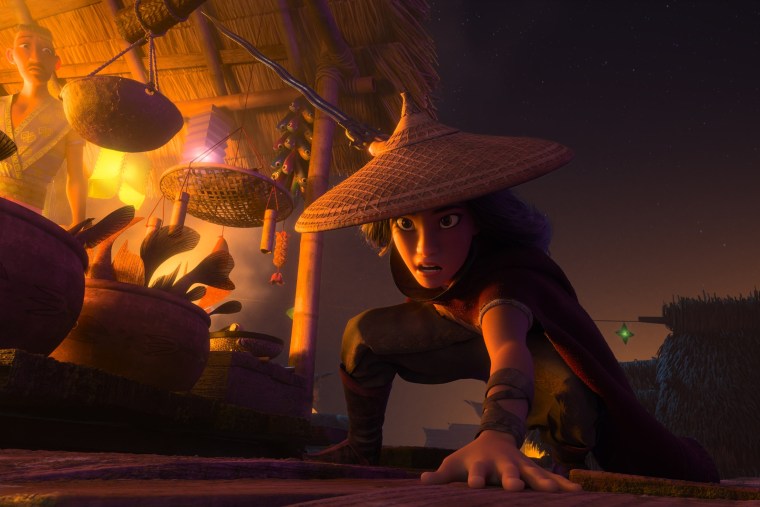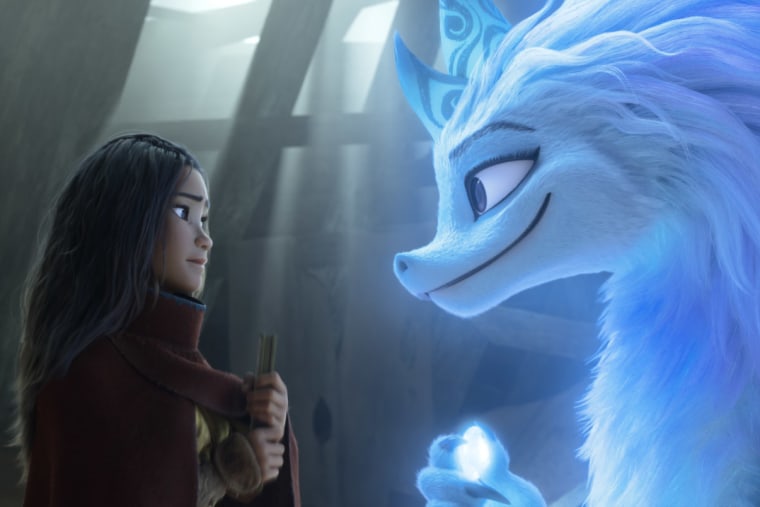Playwright and screenwriter Qui Nguyen says he knew he was onto something with “Raya and the Last Dragon” when his son said, “Raya looks like Grandma when she was a young girl.”
Nguyen co-wrote the screenplay for the new Disney fantasy film, which will be released in theaters and on Disney+ on Friday. He says he's elated his first feature film contains heroes who are “brown," with whom his sons could identify. His parents were Vietnamese refugees who came to the U.S. after the Vietnam War.
“They don't have to trade skins to see themselves as Raya, as Naamari, as Tong, as Boun,” Nguyen told NBC Asian America over Zoom, naming the different characters in the new film. “They can just go: ‘Oh, I look like that character. I don't have to be the, you know, the Asian Spider-Man, I can just be that character, period.’ And that is a very empowering thing for a kid to be able to have.”
The movie also features the studio’s first Southeast Asian princess, Raya, who goes on a quest to find a dragon and reunite the tribes of Kumandra, a land that had been fractured by wars and a plague. Raya is voiced by Kelly Marie Tran, who is Vietnamese American.
At a news conference for the film last week, Kelly Marie Tran said “Raya” made her think of the recent wave of violence against Asian Americans and how to find hope in a world that seems hopeless.
“The only way to really get through it is to look for the bits of hope in your community," Kelly Marie Tran said.
“All of us who have been seeing these attacks happening over and over and over consistently, you do get to that place sometimes where you feel like, ‘Oh, this is a very broken world,’” she said. “The only way to really get through it is to look for the bits of hope in your community.”

Nguyen knows how important it is to see yourself as a hero. He’s been a fan of comic books since he was a kid but he never saw himself reflected in them.
So when Nguyen graduated from college, he founded a theater company in New York City called Vampire Cowboys, where the ethos was to write science fiction and fantasy adventures featuring women, people of color, LGBTQ people — people who might not normally see themselves as heroes.
Just like how the Arthurian legend, "Game of Thrones" and "Dungeons & Dragons" can be seen as a mishmash of Western history,” “Raya” is using Southeast Asian influences to tell a new kind of fantasy story.
A few years ago, Nguyen was hired to write for Marvel Studios, which then led him to Disney and “Raya and the Last Dragon.” “My dream was always to make superheroes, especially superheroes for people who don't often get to see themselves that way,” Nguyen said. “To be able to do this for Asian Americans is truly, truly a huge dream come true — a dream that I always had, that I could never imagine actually happening. And I can't believe that's happening right now.”
“Raya” takes its visual inspiration from many countries, including Laos, Indonesia, Thailand, Vietnam, Cambodia, Malaysia, Singapore and the Philippines. The team also traveled to Southeast Asia for research. Nguyen’s co-writer was Adele Lim, who is Malaysian American and co-wrote the script for “Crazy Rich Asians.” And Thai artist Fawn Veerasunthorn was the head of story.
Just like how the Arthurian legend, "Game of Thrones" and "Dungeons & Dragons" can be seen as a mishmash of Western history,” “Raya” is using Southeast Asian influences to tell a new kind of fantasy story, Nguyen says.
“We're trying to build a big legend. And it could have been really easy to just make it some kind of neutral fantasy land. It was really great to be able to have elements in there that I could point to, that represented the cultures that we grew up in.”
“It was like a bunch of Easter eggs culturally for all of us to be able to go, ‘Hey, you find your culture in this movie,’” screenwriter Qui Nguyen said. “You could build an epic story based on cultures that are Eastern, not just Western.”
For instance, in the film, Raya calls her dad, voiced by Daniel Dae Kim, “Ba,” the Vietnamese word for father. When she makes an offering to Sisu the dragon, she offers bánh tét, a Vietnamese rice cake. There are also shots of durian and dragonfruit.
But it’s not just visual representation. Nguyen was one of the fight consultants on the film and wanted the fight scenes in “Raya” to reflect martial arts that originated in Southeast Asia. Raya carries a sword inspired by the Indonesian kris. And each land in the film has a different fighting style, such as Indonesian Pencak Silat, Muay Thai, and Vietnamese Võ thuật.
“It was like a bunch of Easter eggs culturally for all of us to be able to go, ‘Hey, you find your culture in this movie,’” Nguyen said. “You could build an epic story based on cultures that are Eastern, not just Western.”
Nguyen also has a personal connection to Raya. She is a hero who has lost her friends and family, and is a refugee from her own land. And instead of giving up, she tries to repair the world. To Nguyen, Raya’s journey echoes his own parents, who were refugees who made a better life for themselves. Nguyen also dramatized their story to critical acclaim in his play “Vietgone."
“Anytime you get to see a story that has a Southeast Asian character, it's always about war, it's always about that particular war,” he said, referring to the Vietnam War, which affected not just Vietnam but many countries in Southeast Asia.
To Nguyen, Western narratives about that region are usually rooted in trauma and exoticism: “We are often depicted as the bad guy, the sidekick, or the refugee in a negative context.” By contrast, “Raya” is a story that’s “empowering, and gives a big positive message out to people that look like us.”
And Nguyen said he's aware of the criticism around the voice actors in “Raya”— even though actors of Southeast Asian descent voiced a number of main roles in the film, the cast also contains East Asian Americans actors such as Sandra Oh and Awkwafina.
As a screenwriter, Nguyen wasn’t responsible for the casting, but he did say this: “For the actors that were cast, they have a deep, deep connection to this movie,” he said. “I can't be more thrilled to have these A-list talents be able to represent us out there in the world, because I think that will help get the attention that this movie, this story, and this message deserves.”

“Anytime you get to see a story that has a Southeast Asian character, it's always about war," screenwriter Qui Nguyen said. "By contrast, 'Raya' is a story that’s “empowering, and gives a big positive message out to people that look like us.”
The main message in the film isn’t about finding a dragon or recovering gemstones, though that’s part of it. Raya tries to bring together different groups of people, who have every reason to resent and mistrust each other, and encourages them to work together for the common good — and to fight a plague that threatens to destroy them all.
The team who worked on “Raya” is aware that this all sounds familiar, and eerily prescient. And critics who have seen the film have noted its thematic relevance.
Nguyen thinks “Raya” is an opportunity for families to have tough, complex conversations together and shows how in today’s divided world, Raya may be the hero we all need. Because her superpower isn’t her strength — it’s her empathy, he said.
“Just like ‘Zootopia’ allowed families to talk about bias, just like ‘Big Hero Six’ allowed us to talk about grief, this gives us a chance to talk about the moment in time we're actually in,” Nguyen said. “And have examples of a hero who takes a very brave step in trying to make the world a better place, by building a bridge instead of a wall.”
Follow NBC Asian America on Facebook, Twitter and Instagram.
